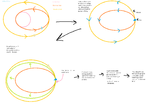Tutorial: Advanced Orbiting/zh-cn
Contents
霍曼转移
在轨道近点发动机点火正向推进(位于正圆轨道则可以在任意时刻进行),直到把轨道远点调整到期望的高度。
然后,当到达新的轨道远点时,再次进行正向推进,把轨道近点调整到期望的高度。
以此类推,在相应点进行反向推进则可以降低轨道高度。
Bi-Elliptical Transfer
The bi-elliptical transfer can be more efficient (but slower) than the Hohmann transfer orbit in some cases.
Start by burning prograde until your orbit becomes elliptical.
At apoapsis, burn prograde until the periapsis reaches the altitude of your desired orbit.
Once reaching periapsis, burn retrograde until your orbit is circularized.
Opposite burns at these same points will lower your orbit. This can be used to allow you to use aerobraking to lower your orbit height.
Orbital Plane Alignment
The first step in intercepting another orbiting body is to align your orbital plane with the target's orbital plane.
Next is to find the pivot point on your orbit that, when turned clockwise or counterclockwise (from the perspective of camera > ship > orbited object), will cause it to line up with the other orbit.
Next, find the midpoint between your prograde and retrograde motion on the horizon and point your ship toward it. Throttling prograde + 90 degrees on the horizon will cause your orbit to rotate clockwise. Prograde - 90 degrees on the horizon will rotate the orbit counterclockwise. It may take a few rotation sessions to perfect your orbit but this will allow you to match another orbital plane.
It is easier to achieve if your orbit is circular, mostly because you can line up the orbits in the map view much more easily.
Orbit Synchronization
In progress.
The Exley Maneuver
(As of 0.17.1)
In order to easily meet with a target planet's Sphere of Influence, you will need to perform a few burns while at either the Periapsis or Apoapsis of your transfer orbit.
Planets outside your original orbit
If you are meeting with a planet whose orbit is outside of your starting orbit, create a transfer orbit such that your Apoapsis is as close as possible to your target planet's orbit.
Next, make a few orbits until the target planet is slightly in front of you when you reach your Apoapsis. Begin a burn in the direction of your velocity until you see your orbit cross the target planet's near your Apoapsis for a fraction of a second. If you overshoot, simply turn around and burn against the direction of your velocity until the cross orbit is visible again. If your transfer orbit exceeds the planet's orbit, then you have gone too far, and have either missed the cross orbit, or do not have an Apoapsis close enough to the target orbit to be affected by the planet's Sphere of Influence.
Planets inside your original orbit
If you are meeting with a planet whose orbit is inside of your starting orbit, create a transfer orbit such that your Periapsis is as close as possible to your target planet's orbit.
Next, make a few orbits until the target planet is slightly behind you when you reach your Periapsis. Begin a burn in the opposite direction of your velocity until you see your orbit cross the target planet's near your Periapsis for a fraction of a second. If you overshoot, simply turn around and burn with the direction of your velocity until the cross orbit is visible again. If your transfer orbit goes within the planet's orbit, then you have gone too far, and have either missed the cross orbit, or do not have a Periapsis close enough to the target orbit to be affected by the planet's Sphere of Influence.
Finally
Once you are in the Cross Orbit, burn against the direction of your velocity until the orbit goes around your target planet.
Good luck!
